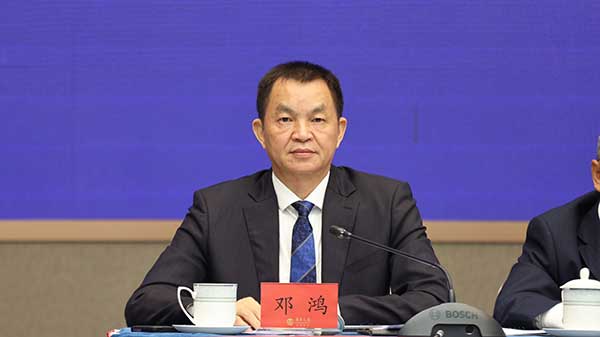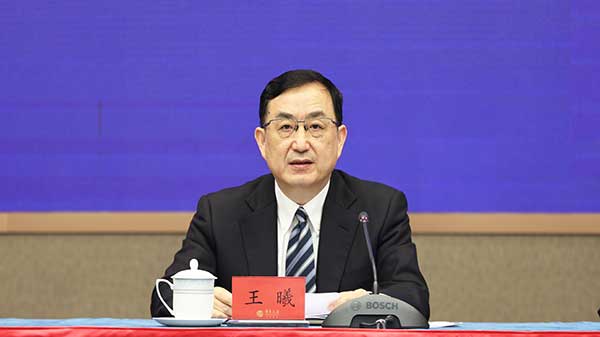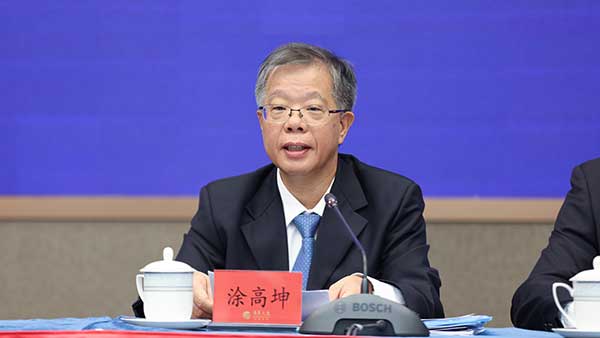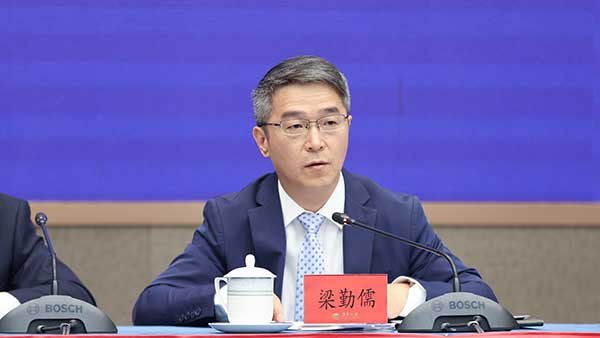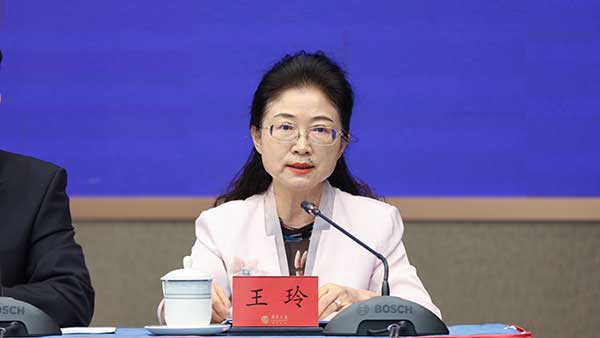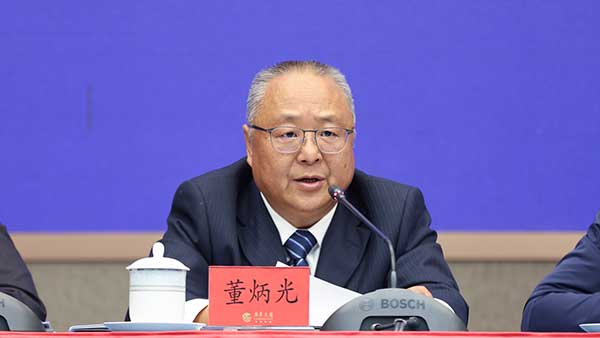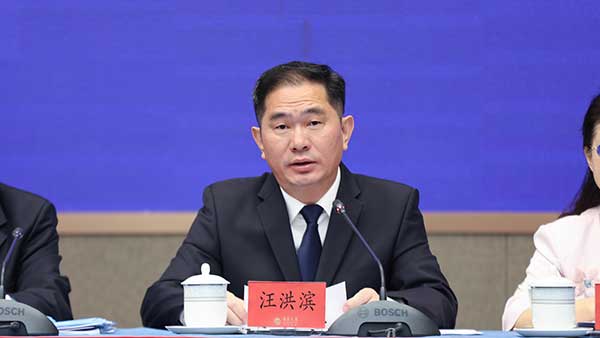On October 9, during the press conference for the “Action Plan for Further Promoting High-Quality Development of the Biopharmaceutical Industry in Guangdong” (hereinafter referred to as the “Action Plan”), it was announced that in 2023, the biopharmaceutical and health industry cluster in Guangdong achieved a revenue of 663.8 billion yuan, ranking among the top in the country. The goal is to exceed one trillion yuan by 2027, with the scale of the pharmaceutical manufacturing industry surpassing 500 billion yuan.
Attendees of the press conference included Wang Xi, member of the Standing Committee of the Guangdong Provincial Party Committee and Vice Governor, Tu Gaokun, Director of the Provincial Department of Industry and Information Technology, Liang Qinu, Deputy Director of the Provincial Department of Science and Technology, Wang Hongbin, Deputy Director of the Provincial Health Commission, Dong Bingguang, Deputy Director of the Provincial Medical Insurance Bureau, and Wang Ling, Deputy Director of the Provincial Drug Administration. The conference was hosted by Deng Hong, Deputy Director of the Guangdong Provincial Government Information Office.
Deng Hong, Deputy Director of the Guangdong Provincial Government Information Office
Deng Hong introduced that various indicators, such as the operating revenue of large-scale biopharmaceutical industrial enterprises, the scale of the medical device industry, the number of relevant industrial parks, and the number of applied biopharmaceutical patents, all rank among the top in the country.
Wang Xi, member of the Standing Committee of the Guangdong Provincial Party Committee and Vice Governor
Wang Xi introduced that the “Action Plan” outlines 38 key tasks and initiatives. In terms of optimizing the system and mechanisms, it aims to improve the collaborative mechanism for industrial development. The plan intends to fully utilize the “lead chain” mechanism of the biopharmaceutical and health industry cluster, enhance the efficient collaborative mechanism involving cross-departmental and key regional participation, deepen the “three-medical coordination,” and strengthen overall coordination. The focus will be on optimizing provincial-level services. It will leverage the geographical advantages and institutional innovation of the Guangdong-Hong Kong-Macao Greater Bay Area, fully utilizing the “Hong Kong-Macao Medical Device Pass” policy to accelerate the expansion of designated medical institutions and product scopes, supporting the nine cities in the Greater Bay Area in connecting with the biopharmaceutical industry in Hong Kong and Macao.
In terms of supporting the entire industrial chain, the “Action Plan” proposes several supportive measures for innovative drugs and medical devices across various aspects, including innovation research and development, platform construction, clinical trials, review and approval, industrialization, and hospital usage. It encourages qualified cities to provide policy and financial support for all segments of the innovation drug and medical device chain, in conjunction with relevant biopharmaceutical policies already implemented in the province. The plan aims to enhance support for various subfields, such as biopharmaceuticals and chemical drugs (including generics), while planning the development of new fields and pathways like gene technology and cell therapy. It also emphasizes the vigorous development of chemical drugs and intermediates, natural medicines, functional components of traditional Chinese medicines, and pharmaceutical excipients in biomanufacturing.
To address bottlenecks in industrial development, the “Action Plan” responds to concerns from enterprises about slow drug and device approvals by establishing a joint service mechanism with the National Medical Products Administration’s Drug and Medical Device Review and Inspection Center for the Greater Bay Area. It aims to create a pre-intervention mechanism and special review procedures for key products such as innovative drugs and medical devices. The plan seeks to accelerate the review and approval of medical device products, aiming to compress the technical review time for Class II medical device registrations by an average of 50% compared to statutory limits. To tackle issues such as slow and difficult hospital admissions for drugs and devices, it mandates that public medical institutions in the province hold at least one meeting of the Pharmacy Management Committee and the Medical Device Management Committee each quarter.
The plan also establishes a fast track for innovative drugs and medical devices, ensuring procurement completion within 15 working days after the submission of application materials is approved. For eligible medical services and technologies, it introduces a “conditionally added project” fee green channel for medical institutions to promote the rapid transformation of innovative results into clinical applications. Additionally, recognizing the shortcomings in the Guangdong biopharmaceutical research and development service platform, chemical raw materials, and traditional Chinese medicinal materials, the plan proposes to introduce and cultivate a group of CROs (Contract Research Organizations), CMO (Contract Manufacturing Organizations), and pilot platforms. It also plans to establish a centralized production base for chemical raw materials and cultivate standardized, scaled, and industrialized planting and breeding bases for traditional Chinese medicinal materials.
In enhancing advantages and forging longer strengths, the “Action Plan” promotes the standardization, internationalization, and modernization of the traditional Chinese medicine industry. It utilizes domestic medical device application demonstrations to boost the scale advantages of the medical device and equipment industries. The plan also leverages technology to empower the elderly care product industry, promoting the research, development, and application of intelligent rehabilitation aids and devices, such as smart walkers and hearing aids. It encourages nursing homes and welfare institutions to accelerate the iteration and upgrading of rehabilitation assistive device facilities.
Tu Gaokun, Director of the Provincial Department of Industry and Information Technology
Tu Gaokun reported that, according to data released by the National Medical Products Administration, by the end of 2023, Guangdong ranked first in the country for drug production licenses, traditional Chinese medicine production enterprises, and medical device manufacturing enterprises, while ranking second for chemical drug production enterprises. The province has one biopharmaceutical company with revenues exceeding 100 billion yuan and 11 companies with revenues exceeding 10 billion yuan. There are nine “single champion” enterprises and 39 nationally recognized specialized and innovative “little giant” enterprises, along with 510 provincial-level specialized and innovative enterprises. The goal is to cultivate and develop at least 15 enterprises with revenues in the hundred billion yuan range by 2027.
Tu Gaokun further explained that Guangdong will keep pace with domestic and international developments in the research and development of innovative drugs and medical devices in clinical stages, introducing promising drug and device applications for industrialization in the province. The plan aims to deeply explore traditional Chinese medicine formulations with unique clinical advantages in local medical institutions and promote the transformation of these formulations into new drugs. Efforts will also be made to attract more national major science and technology projects in the biopharmaceutical field to Guangdong, facilitating the conversion of significant national scientific and technological achievements in the province and nurturing specialized and innovative enterprises.
Additionally, the plan supports the nine cities in the Greater Bay Area in connecting with the biopharmaceutical industries of Hong Kong and Macao, aiming to encourage biopharmaceutical companies from these regions to realize their innovative achievements in Guangdong. To enhance investment attraction, there will be a concerted effort to bring in leading domestic and international biopharmaceutical enterprises, high-end research institutions, and significant industrial projects. At the same time, it will strengthen existing resources based on local conditions, optimize and improve the enterprise cultivation system, and promote innovative development among large, medium, and small enterprises.
The plan emphasizes making key breakthroughs in the entire industrial chain, forming a group of leading enterprises in future life and health. It aims to strengthen policies and services to boost enterprises’ confidence and determination for development in Guangdong. Financial and policy support will be increased, actively providing funding assistance for eligible biopharmaceutical manufacturing innovation centers and projects aimed at enhancing innovation capabilities. Funding rewards will be given to national-level manufacturing champions and specialized and innovative “little giant” enterprises, alongside collaborative efforts with banking institutions to develop financing products tailored for specialized and innovative small and medium-sized enterprises in the biopharmaceutical sector.
Liang Qinu, Deputy Director of the Provincial Department of Science and Technology
Liang Qinru introduced that to fully support research and development innovation in the biopharmaceutical industry and enhance the role of technological innovation in industrial development, the province has implemented multiple specialized projects under key research and development plans. These initiatives actively support biopharmaceutical enterprises and universities in developing high-end medical equipment and innovative drugs that are urgently needed in clinical settings, have large application volumes, and wide applicability. Notable achievements include the approval and industrialization of new drugs such as the Zhongshan Kangfang Cardunil monoclonal antibody injection and Guangzhou Zhongsheng Ruichuang’s Liraglutide. Additionally, Shenzhen Mindray Medical’s R9 color ultrasound and Shenzhen Jingfeng’s surgical robot have reached internationally leading levels.
“By closely relying on leading enterprises, renowned universities, and high-level research hospitals, we are establishing a number of major innovation platforms, including the Guangzhou Laboratory, Biotech Island Laboratory, and Shenzhen Bay Laboratory. These efforts fully support the construction of major scientific infrastructure, such as the Guangzhou Human Cell Lineage and Shenzhen Synthetic Biology Research,” Liang Qinru said. He also noted that Guangdong is strengthening close cooperation with Hong Kong and Macao while leveraging the comprehensive policy advantages of the Greater Bay Area. The province is actively promoting talent attraction through environmental, platform, project, and talent engineering initiatives, gathering a pool of high-level talent in drug discovery, clinical research, and management operations. Statistics show that there are currently over 58,000 research and development personnel in Guangdong’s biopharmaceutical sector, forming a larger, more structurally balanced, and higher-quality talent team.
Wang Ling, Deputy Director of the Provincial Drug Administration
Wang Ling reported that since the implementation of the “Hong Kong-Macao Medical Device Pass” policy in 2021, a fast track has been established for internationally advanced innovative drugs and devices to enter clinical use quickly. This allows drugs already listed in Hong Kong and Macao, as well as medical devices that have been purchased and used by public hospitals in those regions, to be utilized in designated medical institutions in the Greater Bay Area when there is a clinical need, providing significant treatment convenience for residents.
Wang Ling pointed out that, as of now, the “Hong Kong-Macao Medical Device Pass” has designated 45 medical institutions, achieving full coverage across the nine cities in the Greater Bay Area. It has introduced 79 types of drugs and devices (39 drugs and 40 devices) that have been listed in Hong Kong and Macao, benefiting nearly ten thousand residents in the Bay Area and further attracting global multinational pharmaceutical and medical device companies to focus on Guangdong, fostering a favorable environment for the collective development of innovative drugs and devices in the Greater Bay Area. On July 31 of this year, the Guangdong Provincial People’s Congress Standing Committee reviewed and approved the “Regulations on the Management of Imported Hong Kong and Macao Drugs and Medical Devices in the Nine Cities of the Guangdong-Hong Kong-Macao Greater Bay Area.” This legal framework aims to address the difficulties in managing urgently needed Hong Kong and Macao drugs and devices, promoting high-level health development in the Bay Area.
According to Wang Ling, the new management regulations will implement directory management for urgently needed Hong Kong and Macao drugs and devices, with dynamic adjustments announced to the public in a timely manner. The approval time for drugs and devices outside the directory that are urgently needed will be reduced from the original 35 working days to 20 working days, while those within the directory will be shortened from 25 to 10 working days, achieving an average acceleration of 50% and transforming the concept of “waiting for drugs” to “drugs waiting for patients.”
“To further promote high-quality industrial development, Guangdong will encourage global multinational pharmaceutical and medical device companies to utilize the high-quality medical resources in the Guangdong-Hong Kong-Macao Greater Bay Area. Through the ‘Hong Kong-Macao Medical Device Pass’ policy, these companies can conduct real-world studies of urgently needed drugs and devices in designated medical institutions according to national technical guidelines, supporting the registration and listing of effective and urgently needed Hong Kong and Macao drugs and devices in the mainland,” Wang Ling stated.
Dong Bingguang, Deputy Director of the Provincial Medical Insurance Bureau
Dong Bingguang introduced that to implement the National Medical Insurance Administration’s notice on promoting “efficient completion of tasks” in the medical insurance service sector, Guangdong has organized various procurement platforms to develop operational guidelines for the province’s online drug listing. This initiative focuses on innovative drugs, improved new drugs, classical formulas of traditional Chinese medicine, and innovative medical consumables in the categories of chemical drugs, biological products, and traditional Chinese medicine. A fast track for online listing has been established, implementing a corporate commitment system and adhering to the principle of “reporting and reviewing simultaneously.” After the submission of application materials, procurement online will be completed within 15 working days, reducing the administrative burden on enterprises and supporting the rapid listing of innovative drugs and devices, thereby enhancing the innovation enthusiasm among pharmaceutical companies.
Dong Bingguang further explained that to optimize treatment plans for major diseases and rare diseases or to fill gaps in treatment methods, as well as to assist in implementing key national and provincial reform and innovation tasks, a green channel has been opened for medical institutions to apply for medical service pricing projects. This process simplifies procedures, accelerates approvals, and introduces “conditionally added projects,” facilitating the swift clinical application of innovative medical consumables and promoting the development of innovative drugs and devices.
He pointed out that Guangdong has already included 1,655 types of traditional Chinese medicine decoction pieces (including 494 types of Chinese medicine formula granules) within the scope of medical insurance payment. This includes various forms such as broken wall decoction pieces and freeze-dried powders, further supporting the application of traditional Chinese medicine. Additionally, the province actively supports eligible designated medical institutions in providing “Internet+” medical services, incorporating the consultation and medication costs arising from “Internet+” follow-up visits for chronic and common diseases into the medical insurance payment scope.
Wang Hongbin, Deputy Director of the Provincial Health Commission
Wang Hongbin highlighted that regarding the construction of high-level research platforms, Guangdong has established nearly 200 national and provincial medical technology innovation platforms. The scientific and technological capabilities of 50 high-level hospitals in the province have significantly improved, with 12 hospitals ranking among the top 100 in China’s Medical Academy for scientific metrics. In terms of enhancing clinical research capabilities, Guangdong was the first in the country to launch pilot programs for “standardized management of clinical research” and “enhancing clinical research and outcome transformation capabilities in high-level hospitals.” This initiative has led to the establishment of various technical support institutions, including a provincial clinical research quality control center, an ethics quality control center, a clinical research quality control center for stem cells, and a medical science data center. These efforts have facilitated the registration and filing of over 40,000 clinical research projects in medical institutions across the province, accounting for one-fifth of the national total.
To promote the transformation of medical technology achievements, a pharmaceutical achievement transformation platform has been set up. This platform selects and publishes outstanding achievements annually for enterprise collaboration, supporting the transformation of over 300 projects in high-level hospitals in the past two years, with a total transformation value exceeding 3 billion yuan.
Source:Supplied


